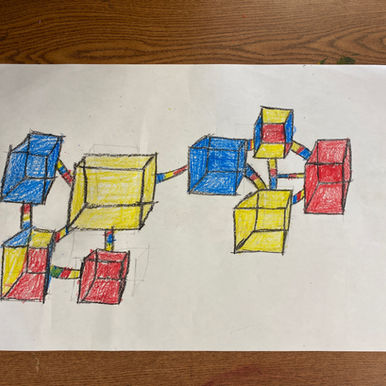
5/31/24
Arts Education Resources
Learning Resource: Abstract Art
by Noormah Jamal, CMA Artist in Residence 2023-24, in collaboration with 5th graders at Children’s Workshop School, NYC
Click to expand media gallery.
View, Download, & Discover More!
Young artists discover Russian artist Wassily Kandinsky, a pioneer of Abstract Art and founder of the Der Blaue Reiter group (The Blue Rider.) Kandinsky regularly explored the theme of the horse and rider - sometimes realistically, but other times by breaking down the familiar image to pure colors and flattened perspective. Through repetition, Kandinsky created abstract compositions that captured the spirit of a subject, rather than its likeness.
Learning Objectives:
Confidently blend primary colors well to make secondary colors. If you mix the primary colors together, you get more colors: red and yellow make orange, red and blue make purple/violet, and yellow and blue make green.
Compose the artwork with intention. Engage spatial awareness of the paper.
Materials:
Drawing paper
Primary colored jumbo crayon
Black jumbo crayon
Ruler
Looking at Abstract Art:
Piet Mondrian (Dutch, b. 1872 – d. 1944) Broadway Boogie Woogie.1942-1943, oil on canvas, Museum of Modern Art, NYC. (LINK)
Jack Whitten (American, b. 1939 –d. 2018) Apps for Obama, Detail. 2011, acrylic collage, courtesy Zeno X Gallery © Jack Whitten, courtesy Zeno X Gallery, Antwerp / John Berens. (LINK)
Carmen Herrera (Cuban, b.1915– d.2022) Iberic. 1949, acrylic on canvas on board, © Carmen Herrera; Courtesy Lisson Gallery, Metropolitan Museum of Art, NYC. (LINK)
Ruth Asawa (American, b. 1926 - d. 2013) Untitled (BMC.93, In and Out), circa 1948–49. Oil and graphite on paper. Private collection. Artwork © 2023 Ruth Asawa Lanier, Inc./Artists Rights Society (ARS), New York. Courtesy David Zwirner. (LINK)
Step 1: Looking at history
Following the principles of Look, Make, Share, introduce the class to the art of Wassily Kandinsky and the concept of abstract art - art that does not aim to represent an accurate picture of reality as we experience it but instead uses shapes, colors, forms, and gestural marks to achieve a specific effect or spirit. Looseness and repetition are techniques often used by abstract artists. While there is an art movement called “Abstraction, ”abstract art exists across cultures and time.
Step 2: Introduction to materials
Provide students with limited colors so they can focus on intentional decision-making. Explain the difference between primary and secondary colors. By offering only primary and black crayons students can focus on layering primary colors to create secondary colors and transparencies as well as the forms they are using on the page.
Step 3: Exploring the elements and principles of art
As students begin their drawing process, discuss the elements of art: color, line, value, and the principles of art: contrast, balance, and movement. Students may still feel a strong impulse to make representational work - support them in loosening their wrist and hand. Consider playing different types of music in the classroom.
Step 4: Presentation
A critical part of the class is sharing the work we made - including the preliminary drawings or drafts. Emphasize the importance of the process and the decision-making involved over the final product alone.
While looking at examples of Abstract Art and while creating your composition, consider the following questions:
Have you ever drawn something so many times that it becomes unrecognizable?
What happens when you loosen your wrist when you draw? How does this affect the composition?
When you look at the referenced artworks are you looking for something familiar? Are you taking in the full image? How do your eyes move across the surface?
Kandinsky thought that the sound of a trumpet was bright yellow. Think of your favorite song. Now imagine drawing it. What colors are in your song?
Instructor Notes:
Carrying out an assignment that is this loose with younger kids has its challenges. They might not fully engage or you run the risk of losing their attention. Music and different genres of it can help lift this lesson. The change in beat or tempo automatically generates a different output from them. Sharing something they are familiar with vs something brand new keeps things exciting.
Examples of Student Work:































